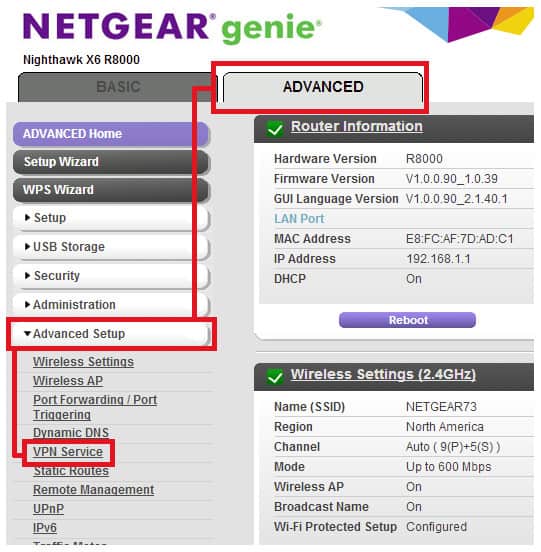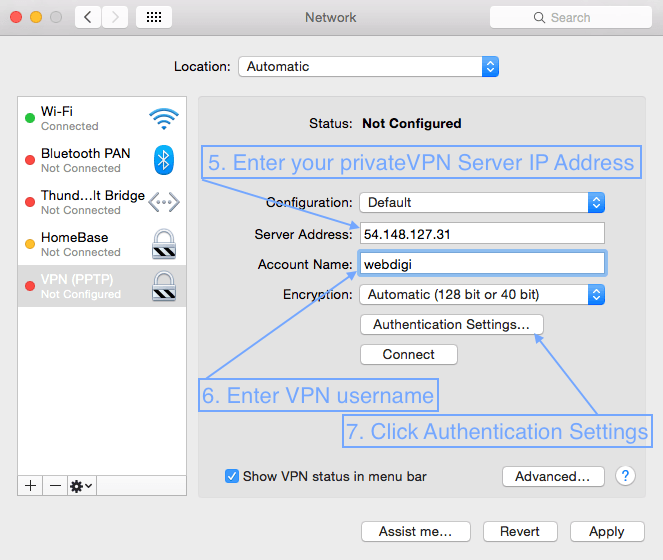PPTP VPN Setup instructions If you don’t want or for some reason can’t install our VPN software, follow our step-by-step tutorial to set up PPTP VPN on macOS: Click on the “apple” on the upper left side of your screen and select “System Preferences” (1).
Download the Flow VPN Client for your Mac from the Apple App Store.
This client is the easiest way to use Flow VPN on a iMac or MacBook system, with no complex configuration required.
PrimoVPN is the first low cost VPN and Incredibly user-friendly client for Mac that is easy to use and reliably establishes a secure network connection. Helps you get out of the trouble all Mac VPN users ran into after upgrading to Mac OS Sierra version - it just runs PPTP protocol. PPTP on Mac OS X This step-by-step tutorial shows how to setup a PPTP connection on Mac OSX Lion. Warning: Please be aware that PPTP has been considered insecure for a few years already and we don't recommend to use it for anything sensitive. Lately I discovered that connecting to a VPN via PPTP option has been removed in the new mac os - sierra. I tried multiple application to do so - all failed. How can I connect to my VPN over PPTP? I don't want to use L2TP because I don't have a pre shared key (I also don't know what it is). Unfortunately Apple has removed the PPTP client from Mac OS Sierra due to PPTP lacking the security features of other VPN protocols. As stated by Apple: If you’ve set up a PPTP VPN server, iOS 10 and macOS Sierra users won’t be able to connect to it. IOS 10 and macOS Sierra will remove PPTP connections from any VPN profile when a user.
Download Flow VPN for Apple Mac
You’ve signed up for Flow VPN and received your VPN login details. Here’s what to do next…
Please note:if you’re looking for instructions on using one of our VPN apps please click here

Download a VPN configuration file - RECOMMENDED

This process will enable you to download a VPN profile that will define settings to access your chosen location / route via both L2TP with PPTP protocols.
1. Select a server location from your client area
2. Download your profile – this will be pre-configured with your chosen location, your username and your VPN password:
3. Open the configuration file. If you’re using Mail you should be able to open the attachment straight from the email; if you’re using webmail you might need to copy it to your desktop first.
4. You’ll be taken to System Preferences > Profiles and prompted to click ‘install’
5. Configuration Profile Tool will ask you to input the password that you use to log into your Mac
6. Your profile will have been installed, preconfigured with your username, password and the server location you selected in step 1.
Note: profiles that don’t state “L2TP” are PPTP

7. To connect, got to System Preferences > Network and select Flow VPN or Flow VPN (L2TP). Click ‘Connect’.
Global VPN app
Search for Global VPN in the Mac App Store.
When the app is installed:
1. Click the blue ‘account’ button and log in with your email address and your chosen Flow VPN password
2. Click ‘Select Country’
3. Choose a server location
4. Click ‘Configure’
5. Accept all prompts as Global VPN creates VPN profiles for PPTP and L2TP protocols
6. To connect, go to System Preferences > Network, select a profile and click ‘Connect’
Manually configure - PPTP
1. Go to System Preferences > Network
2. Click the + button at the bottom of the left panel
3. Select Interface = VPN
4. Select VPN Type = PPTP and type “Flow VPN PPTP” in Service Name
5. Complete the fields as follows:
Server Address: your choice of location, for instance uk.flow.host – you can find the list in your client area
Account name: your email address
6. Click ‘Authentication Settings’ and enter your VPN password – you can find this in your client area (please note that this is not the password used to log into your client area). Click ‘OK’.
7. Click ‘Apply’ then ‘Connect’
Manually configure - L2TP
1. Go to System Preferences > Network
2. Click the + button at the bottom of the left panel
3. Select Interface = VPN
4. Select VPN Type = PPTP and type “Flow VPN L2TP” in Service Name
5. Complete the fields as follows:
Server Address: your choice of location, for instance uk.flow.host – you can find the list in your client area
Account name: your email address
6. Click ‘Authentication Settings’ and enter your VPN password – you can find this in your client area(please note that this is not the password used to log into your client area)
For ‘Shared Secret’, type bewhereprojects
Click ‘OK’.
Pptp Vpn For Mac


7. Click ‘Apply’ then ‘Connect’
OpenVPN
1. Click here to download Go OpenVPN
2. Open the downloaded .dmg file and double-click the Go OpenVPN icon to install the application
3. Open Go OpenVPN. You’ll be asked to enter your Mac user password.
4. Accept the warning:
5. Choose a server from the drop-down menu and enter your FlowVPN account name (probably your email address) and your VPN password. Please note that this isn’t the password you use to log into the FlowVPN website – you can find your VPN password in your FlowVPN client area.
5. Choose a port – we recommend starting with port 1194.
6. Click ‘Connect’!
7. To change servers at any time, simply select a different one from the drop-down menu in Go OpenVPN before you connect.
Frequently asked questions
Which VPN server will give me the fastest connection?
If you’re using a VPN to speed up your internet connection you’ll probably get the best results by choosing the server location that’s nearest to you. Visit your client areato see the available locations.
However, if you are trying to access content on a specific website you should also consider where that website is. For instance, if you’re in Asia and you want to access content in the USA you might find that you get better results by using one of our special ‘via’ routes, for example US via Hong Kong.
Which VPN protocol should I use? PPTP, L2TP or OpenVPN?
Some regular VPN users have a clear personal preference. but if not, it probably comes down to using whichever works best for you.
Some wifi and mobile networks don’t support all connection protocols so you might find that you need to try them all to find the one that works for you.
Vpn For Mac
OpenVPN takes a bit longer to configure, so we’d suggest that you start with PPTP and L2TP, but it’s considered to be a more secure protocol. OpenVPN over SSH – selectable within the FlowVPN OpenVPN application – can be a particularly powerful tool for bypassing firewalls.
How can I delete a VPN profile from my Mac
Mac Pptp Vpn Client
To delete a VPN profile from your Mac, go to System Preferences > Network, select the profile you want to remove and click the – button.
